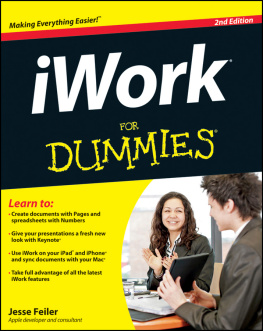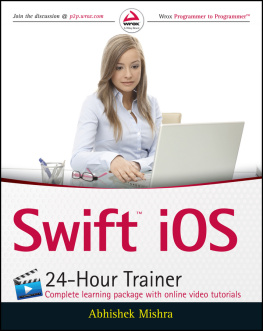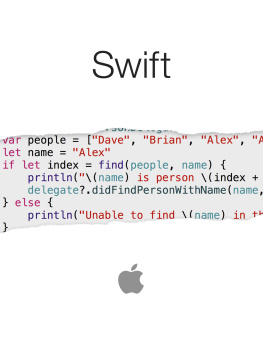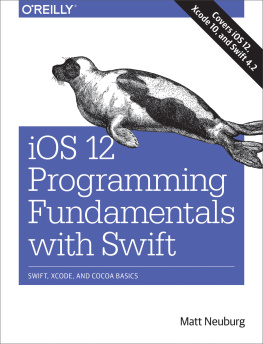
Swift For Dummies
Visit www.dummies.com/cheatsheet/swift to view this book's cheat sheet.
- Table of Contents
Guide
Pages

Swift For Dummies
Published by: John Wiley & Sons, Inc., 111 River Street, Hoboken, NJ 07030-5774, www.wiley.com
Copyright 2015 by John Wiley & Sons, Inc., Hoboken, New Jersey
Media and software compilation copyright 2015 by John Wiley & Sons, Inc. All rights reserved.
Published simultaneously in Canada
No part of this publication may be reproduced, stored in a retrieval system or transmitted in any form or by any means, electronic, mechanical, photocopying, recording, scanning or otherwise, except as permitted under Sections 107 or 108 of the 1976 United States Copyright Act, without the prior written permission of the Publisher. Requests to the Publisher for permission should be addressed to the Permissions Department, John Wiley & Sons, Inc., 111 River Street, Hoboken, NJ 07030, (201) 748-6011, fax (201) 748-6008, or online at www.wiley.com/go/permissions .
Trademarks: Wiley, For Dummies, the Dummies Man logo, Dummies.com, Making Everything Easier, and related trade dress are trademarks or registered trademarks of John Wiley & Sons, Inc. and may not be used without written permission. Swift is a trademark of Apple, Inc. All other trademarks are the property of their respective owners. John Wiley & Sons, Inc. is not associated with any product or vendor mentioned in this book. Swift For Dummies is an independent publication and has not been authorized, sponsored, or otherwise approved by Apple, Inc.
LIMIT OF LIABILITY/DISCLAIMER OF WARRANTY: THE PUBLISHER AND THE AUTHOR MAKE NO REPRESENTATIONS OR WARRANTIES WITH RESPECT TO THE ACCURACY OR COMPLETENESS OF THE CONTENTS OF THIS WORK AND SPECIFICALLY DISCLAIM ALL WARRANTIES, INCLUDING WITHOUT LIMITATION WARRANTIES OF FITNESS FOR A PARTICULAR PURPOSE. NO WARRANTY MAY BE CREATED OR EXTENDED BY SALES OR PROMOTIONAL MATERIALS. THE ADVICE AND STRATEGIES CONTAINED HEREIN MAY NOT BE SUITABLE FOR EVERY SITUATION. THIS WORK IS SOLD WITH THE UNDERSTANDING THAT THE PUBLISHER IS NOT ENGAGED IN RENDERING LEGAL, ACCOUNTING, OR OTHER PROFESSIONAL SERVICES. IF PROFESSIONAL ASSISTANCE IS REQUIRED, THE SERVICES OF A COMPETENT PROFESSIONAL PERSON SHOULD BE SOUGHT. NEITHER THE PUBLISHER NOR THE AUTHOR SHALL BE LIABLE FOR DAMAGES ARISING HEREFROM. THE FACT THAT AN ORGANIZATION OR WEBSITE IS REFERRED TO IN THIS WORK AS A CITATION AND/OR A POTENTIAL SOURCE OF FURTHER INFORMATION DOES NOT MEAN THAT THE AUTHOR OR THE PUBLISHER ENDORSES THE INFORMATION THE ORGANIZATION OR WEBSITE MAY PROVIDE OR RECOMMENDATIONS IT MAY MAKE. FURTHER, READERS SHOULD BE AWARE THAT INTERNET WEBSITES LISTED IN THIS WORK MAY HAVE CHANGED OR DISAPPEARED BETWEEN WHEN THIS WORK WAS WRITTEN AND WHEN IT IS READ.
For general information on our other products and services, please contact our Customer Care Department within the U.S. at 877-762-2974, outside the U.S. at 317-572-3993, or fax 317-572-4002. For technical support, please visit www.wiley.com/techsupport .
Wiley publishes in a variety of print and electronic formats and by print-on-demand. Some material included with standard print versions of this book may not be included in e-books or in print-on-demand. If this book refers to media such as a CD or DVD that is not included in the version you purchased, you may download this material at http://booksupport.wiley.com . For more information about Wiley products, visit www.wiley.com .
Library of Congress Control Number: 2014954655
ISBN 978-1-119-02222-0 (pbk); ISBN 978-1-119-02224-4(ebk); ISBN 978-1-119-02223-7 (ebk)
Introduction
In June of 2014, one of the highlights of Apples Worldwide Developers Conference (WWDC) was the announcement a surprise to many attendees, including the multitudes of developers watching the videos around the world of the development of a new language aimed at developers to use with iOS and OS X devices. Called Swift, it was presented as the language of the future for Apples developers, but it was made very clear that it would cooperate with the existing basic development language Objective-C. (In describing the ways Swift and Objective-C would interact, Apple repeatedly used the phrase mix and match not only in the presentations at WWDC, but in other venues as well.)
Think about that date Swift has only been around since June 2014: Were all beginners with Swift.
About This Book
Swift For Dummies is a beginners introduction to Apples new programming language. The book gets you started developing with Swift. Youll quickly see how to create projects in Swift from the built-in templates that are part of the Xcode development tool. From there, you delve into the features of the language, from the basic to the advanced. Some of these features are unique to Swift whereas other, possibly more familiar features were inherited from other programming languages.
Before we get started with Swift, consider these two points:
- Apple has done this before, and they know how to do it. On both the hardware and software sides, Apple has successfully managed transitions to new technologies. Developers have sometimes cheered, sometimes booed, and even sometimes not even noticed much difference, but nonetheless, Apple has managed to bring them along to a new technology that makes their lives easier and improves things for users.
- The languages are only part of the development environment for Apple. When you develop apps for iOS or OS X, you use the Xcode development tool (technically an Integrated Development Environment, or IDE), the Cocoa or Cocoa Touch frameworks, and a programming language either Objective-C or Swift. What differentiates the iOS and OS X development environment from most others is that the language is only one-third of the overall environment, as well as the fact that a single company (Apple) controls all of that environment.
Conventions Used in This Book
Cocoa is the framework you use for developing Mac apps; Cocoa Touch is the framework for iOS apps. Both have a common heritage and many similar classes. In general, classes that start with NS are Cocoa classes, and classes that start with UI are Cocoa Touch classes. Many Cocoa NS classes are also used in Cocoa Touch, so youll find both types of classes in many of your apps and in the sample code and templates.
Code examples in this book appear in a monospaced font so that they stand out a bit better. Some non-syntax components appear in an italicized monospaced font. (Thus, weatherConditions might be a variable, but variable could be any variable you want to use.)
Like many languages, including Objective-C, Swift is case-sensitive, so please enter the code that appears in this book exactly as it appears in the text. I also use the standard Cocoa naming conventions such as capitalizing class names and leaving the names of methods and instance variables lowercase.
Note that all URLs in this book appear in a monospaced font as well. In accordance with common usage, most URLs in this book include the subdomain (such as www) at the beginning of many URLs except for addresses that dont require that component (such as developer.apple.com
Next page















